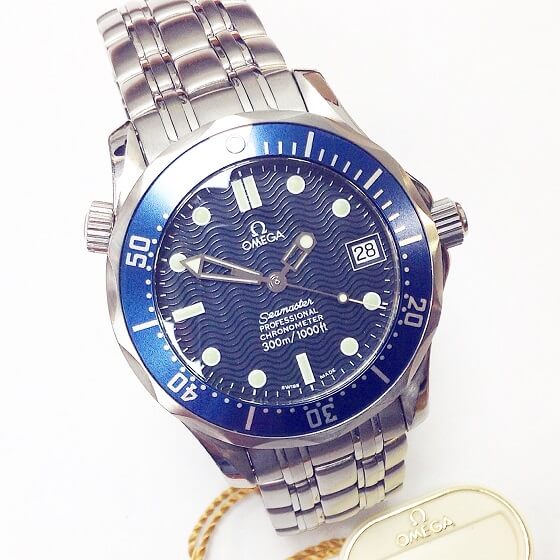A Journey Through Time: The Evolution of the Omega Seamaster
“I had known contemporaries when I was in my twenties who were military and naval […] who all swore by their Omegas.”
Lindy Hemming, Costume Designer for 007
 The early Omega Seamasters are rare and highly collectible. The original model was launched in 1957, along with the Speedmaster and the Railmaster, with divers, drivers and scientists in mind. The first model featured a tachymeter scale bezel and is perfectly proportioned, demonstrating balanced features. In 1959, a second version was released which was slightly wider in diameter and featured an O-Ring Gasket surrounding the buttons, making it more water resistant than its contemporaries.
The early Omega Seamasters are rare and highly collectible. The original model was launched in 1957, along with the Speedmaster and the Railmaster, with divers, drivers and scientists in mind. The first model featured a tachymeter scale bezel and is perfectly proportioned, demonstrating balanced features. In 1959, a second version was released which was slightly wider in diameter and featured an O-Ring Gasket surrounding the buttons, making it more water resistant than its contemporaries.
In 1962, astronaut Willy Schirra wore the Speedmaster on the first flight into space. NASA required a watch which would survive the demanding temperature and pressure changes for future missions and they tested a number of different brands, including a Rolex, Breitling and Longines to find out which would be most suitable. The tests were thorough and, on the 1st March 1965, only the Seamaster had passed and it was distributed to the Gemini-Titan II crew. Buzz Aldrin also wore a Speedmaster for a lunar mission in 1969, making it the first watch on the moon.
Omega débuted a brand new Seamaster 300 in 1964 and, although not dissimilar to the original, this model had a notably larger case which was unusual for its time. This model features unique engravings on the case back and a Circle T on the dial, proudly showing the use of tritium for luminescence, and some of the later versions also feature a large triangle to mark twelve o’clock on the watch face. As a more robust timepiece, it wasn’t long before the Royal Navy recognised the superior qualities of the Omega Seamaster 300 and it became the watch of choice for their divers.
The Seamaster was only used by the Royal Navy for a short time before being replaced by the Rolex, and one of the reasons for this was as a result of its tendency to leak; Omega had recently introduced the Niad pressure-sealing crown, which unfortunately failed to work when in shallow water and under less pressure. This model was only released for a couple of years and they are therefore rather rare.
This generation of the Omega Seamaster 300 fell out of fashion in the 1970s, with many people favouring more contemporary designs, and it was then that the Seamaster 300 became the Seamaster Professional. During this period, they released a number of limited edition Speedmaster Professional watches commemorating the various anniversaries of the NASA space missions.
It wasn’t until 1995 that the original name was reinstated, when The Seamaster featured heavily in Golden Eye, the 1995 James Bond Film, and this exposure brought it back into the limelight. Lindy Hemming’s decision to give 007 the Seamaster was heavily based on its popularity with the British Navy, and they confidently kept with its original strong identity.
The Seamaster 300 features again in Spectre, the latest Bond film, and Omega released a limited edition model to go with this. Unlike its predecessor this model is extremely water resistant, at varying pressure levels, up to 1200m. Featuring a helium escape valve, the gas can escape from the case, when divers are in the decompression chamber, thus keeping it waterproof.
Only time will tell what direction the Speedmaster will go in next. Omega is currently designing and creating a model for a mission to Mars in 2030, which will need to withstand temperatures from -133 degrees Celsius to 27 degrees. Time and time again they exceed expectations and create a model which blows other brands out the water.
If you’d like to discover more about the Omega Seamaster, please pop in and see us at Cuttings.




